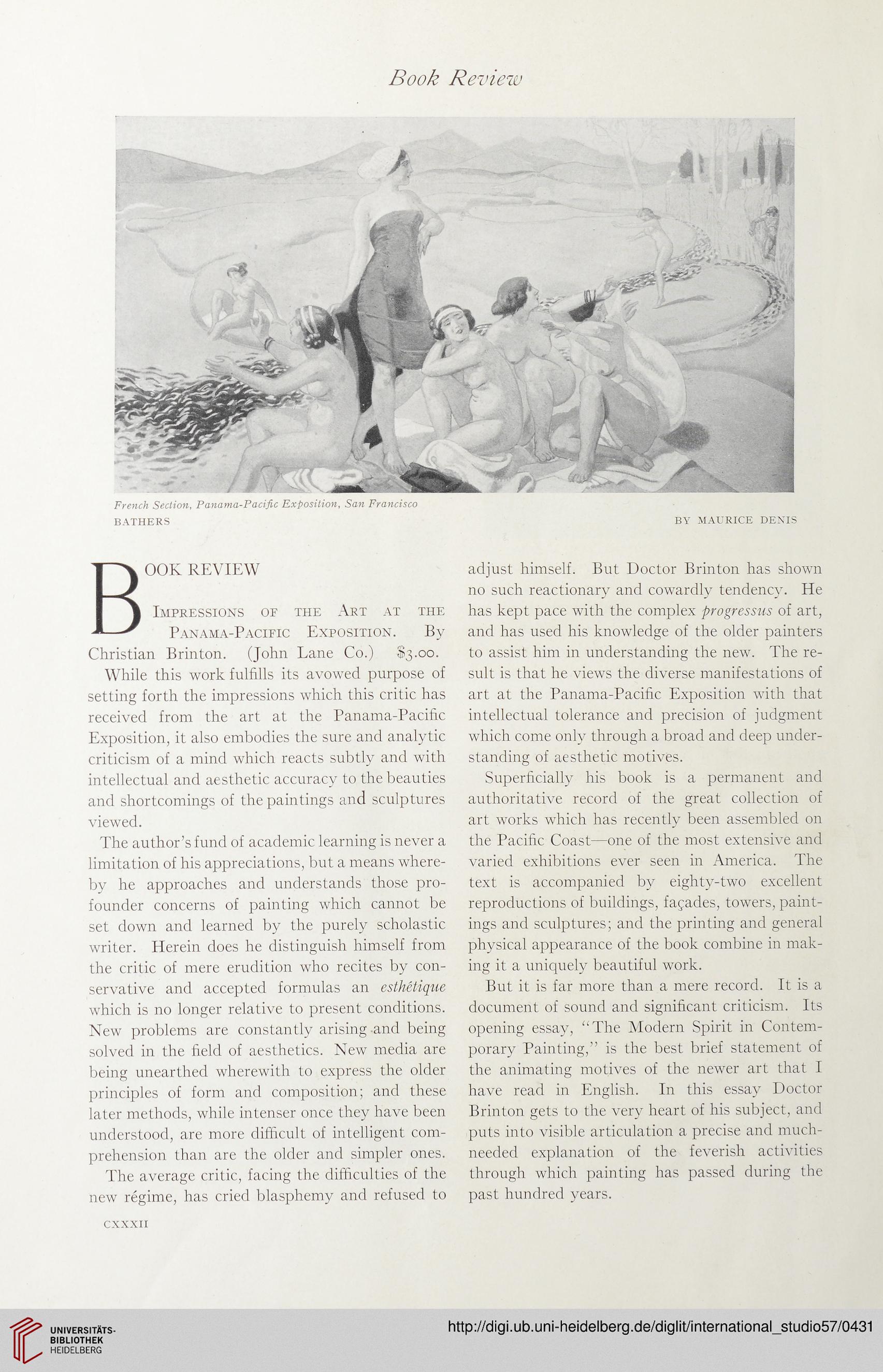Book Review
French Section, Panama-Pacific Exposition, San Francisco
BATHERS BY MAURICE DENIS
OOK REVIEW
Impressions of the Art at the
Panama-Pacific Exposition. By
Christian Brinton. (John Lane Co.) $3.00.
While this work fulfills its avowed purpose of
setting forth the impressions which this critic has
received from the art at the Panama-Pacific
Exposition, it also embodies the sure and analytic
criticism of a mind which reacts subtly and with
intellectual and aesthetic accuracy to the beauties
and shortcomings of the paintings and sculptures
viewed.
The author’s fund of academic learning is never a
limitation of his appreciations, but a means where-
by he approaches and understands those pro-
founder concerns of painting which cannot be
set down and learned by the purely scholastic
writer. Herein does he distinguish himself from
the critic of mere erudition who recites by con-
servative and accepted formulas an esthetique
which is no longer relative to present conditions.
New problems are constantly arising and being
solved in the field of aesthetics. New media are
being unearthed wherewith to express the older
principles of form and composition; and these
later methods, while intenser once they have been
understood, are more difficult of intelligent com-
prehension than are the older and simpler ones.
The average critic, facing the difficulties of the
new regime, has cried blasphemy and refused to
adjust himself. But Doctor Brinton has shown
no such reactionary and cowardly tendency. He
has kept pace with the complex progressus of art,
and has used his knowledge of the older painters
to assist him in understanding the new. The re-
sult is that he views the diverse manifestations of
art at the Panama-Pacific Exposition with that
intellectual tolerance and precision of judgment
which come only through a broad and deep under-
standing of aesthetic motives.
Superficially his book is a permanent and
authoritative record of the great collection of
art works which has recently been assembled on
the Pacific Coast—one of the most extensive and
varied exhibitions ever seen in America. The
text is accompanied by eighty-two excellent
reproductions of buildings, facades, towers, paint-
ings and sculptures; and the printing and general
physical appearance of the book combine in mak-
ing it a uniquely beautiful work.
But it is far more than a mere record. It is a
document of sound and significant criticism. Its
opening essay, “The Modern Spirit in Contem-
porary Painting,” is the best brief statement of
the animating motives of the newer art that I
have read in English. In this essay Doctor
Brinton gets to the very heart of his subject, and
puts into visible articulation a precise and much-
needed explanation of the feverish activities
through which painting has passed during the
past hundred years.
cxxxii
French Section, Panama-Pacific Exposition, San Francisco
BATHERS BY MAURICE DENIS
OOK REVIEW
Impressions of the Art at the
Panama-Pacific Exposition. By
Christian Brinton. (John Lane Co.) $3.00.
While this work fulfills its avowed purpose of
setting forth the impressions which this critic has
received from the art at the Panama-Pacific
Exposition, it also embodies the sure and analytic
criticism of a mind which reacts subtly and with
intellectual and aesthetic accuracy to the beauties
and shortcomings of the paintings and sculptures
viewed.
The author’s fund of academic learning is never a
limitation of his appreciations, but a means where-
by he approaches and understands those pro-
founder concerns of painting which cannot be
set down and learned by the purely scholastic
writer. Herein does he distinguish himself from
the critic of mere erudition who recites by con-
servative and accepted formulas an esthetique
which is no longer relative to present conditions.
New problems are constantly arising and being
solved in the field of aesthetics. New media are
being unearthed wherewith to express the older
principles of form and composition; and these
later methods, while intenser once they have been
understood, are more difficult of intelligent com-
prehension than are the older and simpler ones.
The average critic, facing the difficulties of the
new regime, has cried blasphemy and refused to
adjust himself. But Doctor Brinton has shown
no such reactionary and cowardly tendency. He
has kept pace with the complex progressus of art,
and has used his knowledge of the older painters
to assist him in understanding the new. The re-
sult is that he views the diverse manifestations of
art at the Panama-Pacific Exposition with that
intellectual tolerance and precision of judgment
which come only through a broad and deep under-
standing of aesthetic motives.
Superficially his book is a permanent and
authoritative record of the great collection of
art works which has recently been assembled on
the Pacific Coast—one of the most extensive and
varied exhibitions ever seen in America. The
text is accompanied by eighty-two excellent
reproductions of buildings, facades, towers, paint-
ings and sculptures; and the printing and general
physical appearance of the book combine in mak-
ing it a uniquely beautiful work.
But it is far more than a mere record. It is a
document of sound and significant criticism. Its
opening essay, “The Modern Spirit in Contem-
porary Painting,” is the best brief statement of
the animating motives of the newer art that I
have read in English. In this essay Doctor
Brinton gets to the very heart of his subject, and
puts into visible articulation a precise and much-
needed explanation of the feverish activities
through which painting has passed during the
past hundred years.
cxxxii




